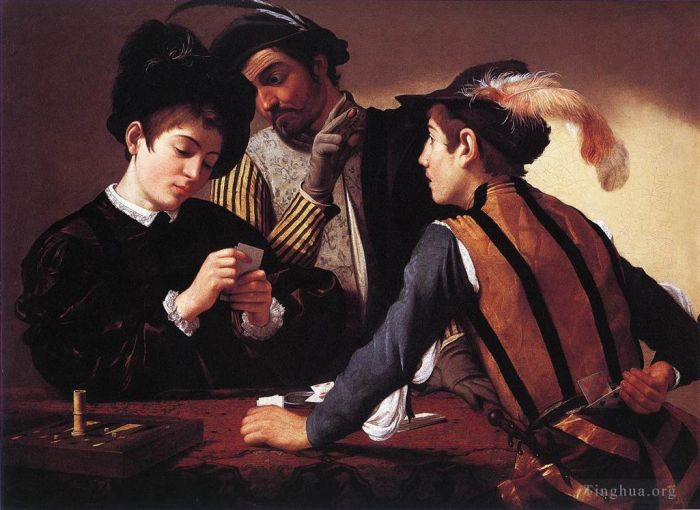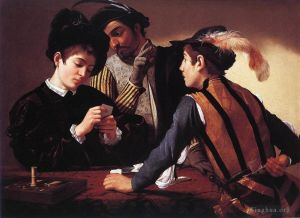The Cardsharps
Caravaggio
- Price: Price on Request
- Art Type: Oil Painting
- Size:
- English Comments: 0
- International Comments: 0
- Creating Date:
- Introduction and Works of Caravaggio >>
Keywords:
Cardsharps
Work Overview
- The Cardsharps
Italian: Bari
Artist Caravaggio
Year c. 1594
Medium Oil on canvas
Dimensions 94 cm × 131 cm (37 in × 52 in)
Location Kimbell Art Museum, Fort Worth
The Cardsharps (painted around 1594) is a painting by the Italian Baroque artist Michelangelo Merisi da Caravaggio. The original is generally agreed to be the work acquired by the Kimbell Art Museum in 1987, although Caravaggio may have painted more than one version.
The work represents an important milestone for Caravaggio.[1] He painted it when he was attempting an independent career after leaving the workshop of the Cavaliere Giuseppe Cesari d'Arpino, for whom he had been painting "flowers and fruit", finishing the details for the Cavaliere's mass-produced (and massive) output. Caravaggio left Arpino's workshop in January 1594 and began selling works through the dealer Costantino, with the assistance of Prospero Orsi, an established painter of Mannerist grotesques (masks, monsters, etc.). Orsi introduced Caravaggio to his extensive network of contacts in the world of collectors and patrons.
The painting shows an expensively-dressed but unworldly boy playing cards with another boy. The second boy, a cardsharp, has extra cards tucked in his belt behind his back, out of sight of the mark but not the viewer, and a sinister older man is peering over the dupe's shoulder and signaling to his young accomplice. The second boy has a dagger handy at his side, and violence is not far away.
It was the second such painting Caravaggio created. The first, The Fortune Teller, had drawn attention, and this painting extended his reputation, small though it was at this stage. The subjects of The Fortune Teller and Cardsharps offered something new, realistic scenes of street life, especially with this beautifully rendered attention to little details such as the split fingers on the older man's gloves, or the teenage cheat's anxious glance at his master. The psychological insight is equally striking, the three figures bound together by the common drama, yet each with his own unique part within the larger play – for if the innocent is being duped, the other boy is no older, another innocent being corrupted even as he cheats his gull.
Cardsharps, with its mixture of brutal low-life realism and luminous Venetian delicacy, was much admired, and Orsi "went around acclaiming (Caravaggio's) new style and heightening the reputation of his work." Caravaggio appears to have produced more than one version of the work (as discussed in the provenance section below). Over fifty copies and variants made by other painters have survived, with artists such as Georges de La Tour painting their own appreciations of the theme.
Whether through Costantino or Orsi, Caravaggio came to the notice of the prominent collector Cardinal Francesco Del Monte, who purchased Cardsharps and became the artist's first important patron, giving him lodgings in his Palazzo Madama behind the Piazza Navona,[2] then as now one of the principal squares in Rome.
From Del Monte's collection the work entered the collection of Cardinal Antonio Barberini, nephew of the Pope Urban VIII (whose pre-elevation portrait, Portrait of Maffeo Barberini, Caravaggio would paint in 1598), in Rome and was passed through the Colonna-Sciarra family.[3] It eventually disappeared in the 1890s, and was rediscovered in 1987 in a private collection in Zürich;[4] it was subsequently sold to and is currently in the collection of the Kimbell Art Museum in Fort Worth, Texas.
The British art historian Denis Mahon acquired a copy of Cardsharps at auction in 2006. Although it had been sold by Sotheby's as being a copy of the work in the Kimbell Art Museum and by an artist other than Caravaggio, Mahon argued that it was a replica by Caravaggio himself. There is a pentimento, in which full detail of the face of one of the cheats had been sketched in spite of being painted over by the page's hat. This suggests that it is unlikely that it was done by a copy artist.[5] The attribution of this version to Caravaggio has been widely accepted, although as of 2014 it is the subject of a legal dispute.[6] This suggests that Caravaggio might have painted at least two versions of the work (as he is believed to have done with Boy Bitten by a Lizard, The Fortune Teller and The Lute Player. Sir Denis Mahon died in 2011 and the painting had been loaned to London's Museum of the Order of St. John and insured for £10,000,000.[7] On January 16, 2015, the High Court of England and Wales ruled in favor of Sotheby's,[8] saying that, relying on qualified experts, Sotheby's had reasonably come to the view that the painting was not likely a Caravaggio; the judge consequently ordered the plaintiff to pay Sotheby's £1.8 million for its legal fees.
Caravaggio was one of the pivotal figures in the history of Western art. In his short lifetime, he created a theatrical style that was as shocking to some as it was new, inspiring others to probe their subject matter for the drama of psychological relationships. Apprenticed in Milan, Caravaggio came to Rome in the early 1590s. There his early masterpiece The Cardsharps came to the attention of the influential Cardinal Francesco Maria del Monte, who not only purchased it but also offered the artist quarters in his palace. Caravaggio was thus introduced to the elite stratum of Roman ecclesiastical society, which soon gave him his first significant opportunity to work on a large scale and for a public forum. In The Cardsharps, the players are engaged in a game of primero, a forerunner of poker. Engrossed in his cards at left is the dupe, unaware that the older cardsharp signals his accomplice with a raised, gloved hand (the fingertips exposed, better to feel marked cards). At right, the young cheat looks expectantly toward the boy and reaches behind his back to pull a hidden card from his breeches. Caravaggio has treated this subject not as a caricature of vice but in a novelistic way, in which the interaction of gesture and glance evokes the drama of deception and lost innocence in the most human of terms. The Cardsharps spawned countless paintings on related themes by artists throughout Europe—not the least of which was Georges de La Tour’s Cheat with the Ace of Clubs in the Kimbell. The Cardsharps was stamped on the back with the seal of Cardinal del Monte and inventoried among his possessions after his death in 1627. Its location had been unknown for some ninety years when it was rediscovered in 1987 in a European private collection.
The Cardsharps, lost for almost a century, has been found and is now in Texas, and helps to fill in an important stage in the development of Caravaggio's art. Behind a table that protrudes into the spectator's space, a youthful innocent studies his cards, overlooked by a sinister middle-aged man, whose fingers signal to another, younger scoundrel to his right, who holds a five of hearts behind his back. To the left-hand side of the canvas is the object of their conspiracy, a pile of coins.
This low-life scene links Caravaggio's discreet dramas to the genre paintings favoured by his followers. It was to have many imitators - within a few years of the painter's death an early variant had been painted by the Franco-Roman Valentin de Boulogne - but few equals. Caravaggio was less melodramatic than many of the artists known as the Caravaggisti who painted in his style, and he suggests only enough of the interaction between the three actors to imply the sequel.
- Copyright Statement:
All the reproduction of any forms about this work unauthorized by Singing Palette including images, texts and so on will be deemed to be violating the Copyright Laws.
To cite this webpage, please link back here.
- >> English Comments
- >> Chinese Comments
- >> French Comments
- >> German Comments
- >>Report
- Saint Jerome in Meditation
- Still Life with Flowers and Fruit
- The Musicians
- St John the Baptist Youth with Ram
- Supper at Emmaus
- Madonna and Child with St Anne
- Flagellation
- The Sacrifice of Isaac
- Young Sick Bacchus
- Nativity with St Francis and St Lawrence
- Portrait of Alof de Wignacourt1
- St John the Baptist
- The Sacrifice of Isaac2
- The Conversion of St Paul
- David with the Head of Goliath
- The Crucifixion of Saint Peter
- St John the Baptist1
- Narcissus
- Medusa
- Beheading of Saint John the Baptist
- The Martyrdom of St Matthew
- Boy with a Basket of Fruit
- The Denial of St Peter
- Salome with the Head of the Baptist
- Portrait of Alof de Wignacourt2
- St John the Baptist2
- St Francis1
- Saint Jerome Writing (Saint Jerome in His Study or simply Saint Jerome)
- Adoration of the Shepherds
- St Francis2
- Sleeping Cupid
- Saint Jerome Writing
- Christ in the Garden
- Jupiter Neptune and Pluto
- St John the Baptist at the Well
- Portrait of Maffeo Barberini
- The Crucifixion of St Andrew
- David with the head of Goliath
- Portrait of a Courtesan
- The Crowning with Thorns2
- Burial of St Lucy
- St Matthew and the Angel
- Boy Peeling a Fruit
- Ecce Homo
- The Seven Acts of Mercy
- The Entombment
- St Francis in Ecstasy
- The Inspiration of Saint Matthew
- Lute Player
- Judith Beheading Holofernes
- St John the Baptist
- The Incredulity of Saint Thomas
- The Fortune Teller
- The Tooth Drawer
- St Catherine of Alexandria
- Basket of Fruit still life
- David with the Head of Goliath
- The Crowning with Thorns
- Bacchus
- The Calling of Saint Matthew
- Boy Bitten by a Lizard
- The Raising of Lazarus
- Salome with the Head of St John the Baptist
- Magdalene
- The Conversion on the Way to Damascus
- Rest on Flight to Egypt
- The Fortune Teller
- The Lute Player
- The Annunciation
- Taking of Christ
- Amor Victorious
- Madonna di Loreto
- Christ at the Column
- The Death of the Virgin
- The Martyrdom of St Ursula
- Madonna del Rosario
- The Cardsharps
- Supper at Emmaus
- Martha and Mary Magdalene









 Singing Palette
Singing Palette